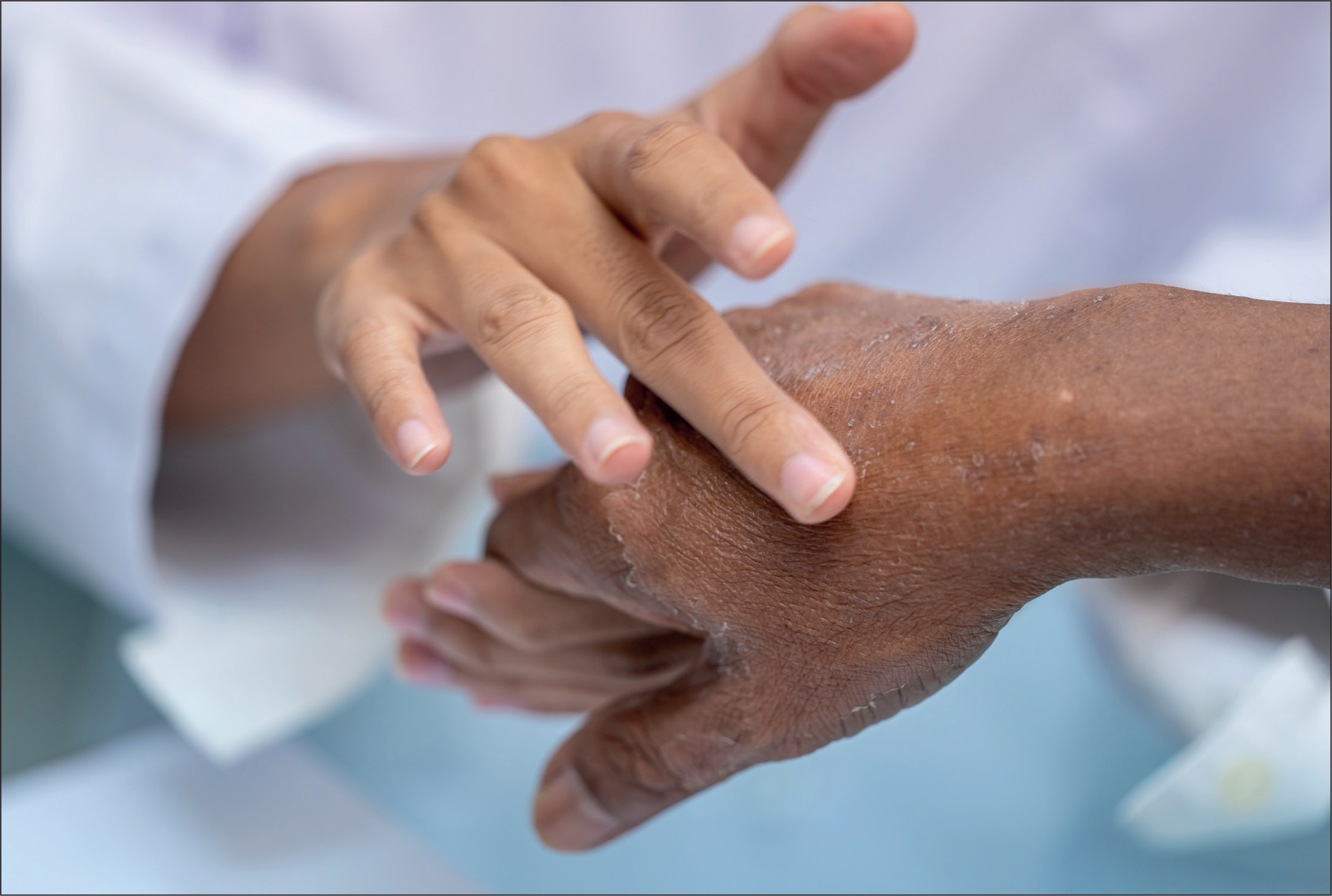Through caring for older adults in the community, nurses will encounter various dermatological conditions, as the skin becomes thinner, drier and more delicate with age, growing more prone to tearing, damage and various skin conditions. Being the largest organ, as well as being external, the skin is vulnerable, and the importance of proper care for this part of the body cannot be underestimated. Furthermore, issues associated with the skin, such as various types of dermatitis, may manifest in red, scaly or blotchy skin, itching (pruritis) and potential tissue drainage of exudate. These are often associated with significant psychological impact to a person's self-esteem, body image and sexuality.
There are many inflammatory skin conditions, which vary in aetiology. Some common manifestations include pruritis, erythema, scaling, vesicles and lichenification, where there is chronic inflammation (British Medical Journal (BMJ), 2018; Palmer, 2020). While it can be occasionally difficult to differentiate between conditions, as they may present in a similar way, each has distinct signs and symptoms of its own.
For example, eczema consists of dry, itchy skin, with typical manifestations of erythema, scaling or vesicles, and lichenification in skin flexures in cases of chronic inflammation (BMJ, 2018). However, irritant contact dermatitis results from direct toxicity, and may occur in any person without prior sensitisation. On the other hand, allergic contact dermatitis is a delayed hypersensitivity reaction requiring prior sensitisation (BMJ, 2018). Both present with localised burning, stinging, itching, blistering, erythema and swelling following contact with an allergen or irritant, as well as the possibility of hyperpigmentation, fissuring and scaling. Dyshidrotic dermatitis involves recurrent crops of 1 to 2 mm vesicles, with pruritus on the palms, soles, and/or lateral aspects of the fingers (Palmer, 2020). Pompholyx is more acute and involves severe eruptions of large bullae on the hands and feet. The significant exacerbating factor is irritation, often associated with frequent hand washing, hyperhidrosis and stress, although the underlying aetiology is unknown (Palmer, 2020).
Therefore, patients should be taught how to maintain effective skin barrier mechanisms, such as through the use of emollients and the avoidance of irritants. Where these lifestyle measures are changed, but the patient is not responsive to such amendments, topical corticosteroids or immunomodulators would be used. Some cases are more severe, with eruptive bullae on the palms and soles, which oral corticosteroids are useful for. For recalcitrant cases, many options are available, including phototherapy, oral immunosuppressants or nickel-directed therapy (BMJ, 2018).
With the skin being so visible, there can be a stigma attached to skin conditions, and issues may arise related to a person's self-confidence and perceived body image. In fact, in the case of psoriasis, several studies focus on its effect on quality of life, including psychological comorbidities, such as depression and anxiety (Martínez-García et al, 2014; Bakar et al, 2021; Pollo et al, 2021). While psoriasis can affect any part of the body, the scalp is involved in up to 80% of cases (Papadimitriou et al, 2021). Symptoms-such as often intense scaling, erythema and persistent pruritis, to name a few—present not only a physical burden, but also a significant psychological impact and regression in patients' quality of life, which, as researchers point out, is disproportional to the affected body area (Papadimitriou et al, 2021). However, despite its common presentation, the scalp is an area that continues to present challenges to clinicians in terms of achieving an adequate clinical response and satisfactorily meetings patients' needs (Papadimitriou et al, 2021). In the case of chronic oedema, Green (2008) discusses the significant effects on a person's body image due to the condition—not only because of changes to the skin, but also the associated swelling, which changes the size and shape of a person's limb, hindering a person's freedom to confidently choose and wear the clothes they wish to.
Even in the case of eczema, psoriasis or contact dermatitis on a person's arms, shoulders, chest or upper back, a person may not feel comfortable wearing short sleeves, sleeveless tops or styles of clothing with a scoop neck or open back, as they may feel self-conscious and wish to cover their skin when they go out. Some patients may avoid social engagements altogether because of the appearance of their skin, the discomfort and self-consciousness of itching, feelings of shame around any odour that may be associated with leaking exudate, or pain associated with scaling, swelling or itching.
Similarly, the lack of confidence that may be triggered by dermatological conditions may result in the avoidance of romantic partners or sexual activity. This is natural but concerning, considering societal taboos in relation to older people and sexuality (International Centre for Longevity-UK, 2011) and potentially damaging attitudes, myths and stereotypes around sexuality and ageing (Heath et al, 2018), even without the added stigma of dermatological or other conditions.
Broaching subjects such as sexuality or even appearance with patients can be difficult, and Clarke and Cooper (2001) highlighted that nurses generally felt much more comfortable with the traditional delivery of nursing care than they did with providing psychosocial support. However, Rumsey et al (2002) suggested that nurses in the community have ideal opportunities to explore patient concerns while engaged in other interventions, such as changing a dressing. They offer that finding a shared vocabulary, void of value judgements, may provide the key to effective communication with patients with dermatological concerns. For example, using the word ‘swollen’ is favourable to the word ‘bloated’; rather than saying a patient's skin is unsightly, it is more appropriate to objectively describe physical features of the skin's condition with words such as ‘pink’, ‘sore’ or ‘rough’. Being mindful of language used will not only lead to more effective communication, and hopefully identification and resolution of patient concerns, but also a much more compassionate approach and therapeutic connection.



